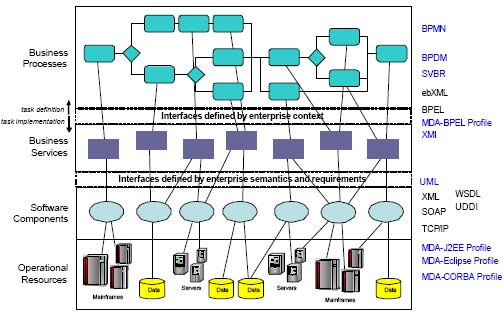The opening keynote this morning was by Prof. August-Wilhelm Scheer, the founder and serious brain-trust behind IDS Scheer. You have to love this guy: not only is he brilliant and able to describe his ideas clearly, he opened and closed his session by playing sax in a jazz trio on stage.
He covered a lot of material in his talk, and I can’t begin to do it justice but will try to hit a few of the high points.
The goal of a modelling tool like ARIS is to support business processes from strategy to model to detailed description to implementation, including changes to any part of that chain and how the changes ripple through the other layers. The design-implementation-control life cycle of business processes, with a current strong focus on the optimization end of things, serves to bring together process modelling and execution like never before.
The business model at the top of any business process is the key competitive differentiator for an organization, requiring identification of the value proposition, supply chain, and target customer. This places the business model, and the surrounding business architecture, as part of an overall enterprise architecture. Looking at the business process architecture stack (think Zachman column 2), the business model leads to the business process, which requires/populates the business process repository. This, in turn, populates the IT-business process repository for the subset of the processes to be automated, through standardized modelling formats like BPMN and serialization formats like BPEL, which in turn connect to the enterprise service repository that documents the underlying services. Surrounding all this is the business process platform for service assembly/orchestration, portals, B2B, WFMS (wow, haven’t heard that term for a while: workflow management systems, for the youngsters in the crowd) and EAI.
IDS Scheer is involved with (or at least concerned with) a number of process-related standards, including ones such as BPMN and IDEF at the business process modelling level. I’m interested to see if they’re involved in the BPM Think Tank that OMG runs, such as the one coming up in July in San Francisco — an email exchange with someone from OMG a few minutes ago indicate that they’re not heavily involved in OMG standards. ARIS’ business model metamodel and their generally high level of innovation could almost certainly contribute to OMG standards development, if they’re not already.
One interesting point that Prof. Scheer finished with (well, before he started playing sax again) was that BPMS (i.e., process execution) vendor platforms will continue to be proprietary in spite of their “commitment” to standards (my quotation marks, since I agree with this thought), so products like ARIS are necessary in order to help facilitate the movement of models between execution systems. The business view needs to be open, while the implementation layer will remain proprietary.

